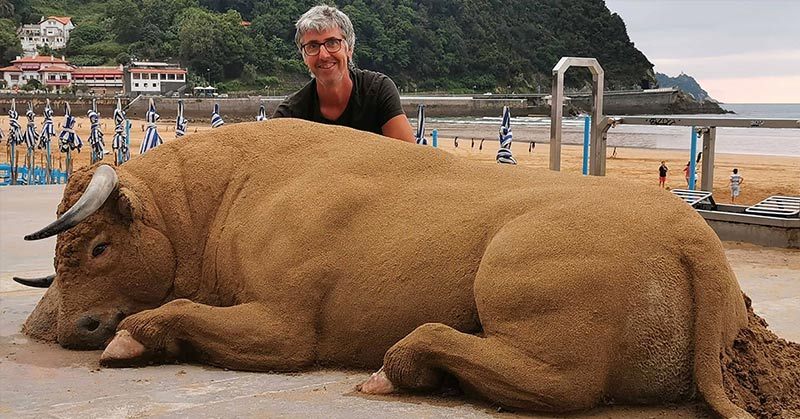Sand art is one of the most underrated forms of art in the modern world. This may be because, while being aesthetically pleasing, their effects are transient as they tend not to last, not to mention they are almost impossible to transport. Some may say sand art is ‘not real art’ but these aren’t your everyday sandcastles here folks. Since the dawn of time, art has been regarded as “self-expression” and sand, rocks, feathers, plain white paper, and glass shards are as good as any medium for an artist to channel their creativity. These sand animal sculptures take it to a new level!

A talented artist named Andoni Bastarrika spends a lot of his time at the beach working with sand and taking the art to a whole new level of mind-blowing. Bastarrika creates hyperrealistic sand sculptures of animals that are so real you’d probably call Animal Control if you view them from a distance. He’s modeled horses, cattle, dogs, sharks, squids, elephants, crocodiles, and the results are always just super-stunning. Along with the animals, he would also create the perfect environments to make the pictures seem more realistic, such as a whale squirming, a dolphin on a wave, or a horse sitting against a shallow hill. Of course, everything is sculpted with sand.

Speaking to Bored Panda, Bastarrika explains that working with sand helps him put the “fluidity of his hands” to good use, and he’s been sand-sculpting since 2010.
“The sand fascinates me because no matter how you look at it, it will always teach you things if you are willing to learn,” he wrote on Facebook. “In order to create a sculpture, an unthinkable number of sand particles participate, hugging each other tightly through humidity, so that someone could model their union. And once the artist steps back, its piece will remain at the mercy of nature, meaning that sooner or later the wind will dry them up and release each particle, slowly consuming all the individuality and authenticity.“
Read: Ukrainian Photographer Captures a Magical World of Snails in Incredible Macro Shoot
Sand art: only if humans would emulate the unity of the molecules
Talking about his attraction to sand, Bastarrika explains that he’s captivated by the way the molecules attach so tightly to one another, and he believes this is something humanity can emulate.
“To create a beautiful world, we should all embrace each other just as tightly,” he said.
Also, he prefers to create animal sculptures because these creatures have free spirits with no hindrance or limitations, and a deep-running yearning to thrive and explore. Each animal sculpture represents a wealth of wisdom that’s unique and beautiful in its own way. He also prefers not to place artificial adornments such as necklaces or tiaras on the animals.
“There’s the nudity they bring with themselves to this world at birth which they keep until their death,” he said. “That nudity — at least to me — symbolizes freedom, the essential ingredient to being able to truly live. Humans ‘overdress’ to survive in a lot of ways. I have never made nor will I make an animal with a necklace or chains. I prefer to embrace their freedom, power, and wisdom through beauty rather than a form of suffering.“
Read: Explore These Upside Down Houses
The process of making a sand animal sculpture
Bastarrika’s work is almost like every one of those hand-sculpted sand castles we all make, except that things happen on a much larger scale. He sculpts a heap of wet sand with his hands and several length and sizes of sticks. Each project takes anywhere from a few hours to a couple of days to complete. To give his sand animal sculpture life, he sometimes uses colored stone powder, ashes, clay powder, or colorful glass shards.
“The time it takes to create one piece largely depends on its size,” Bastarrika explained. “The elephant, for example, took me two days, while the horse and the bison took 12 hours each. The dogs, which were smaller, needed about six to eight hours.”
See some of Bastarrika’s hugely satisfying pieces below:














- Mindaugas Balciauskas. Brittanica. https://www.britannica.com/topic/philosophy-of-art/Art-as-expression Retrieved 25-05-2020 Retrieved 25-05-2020
- Andoni Bastarrika. Facebook. https://web.facebook.com/andoni.bastarrikairuretagoyena?_rdc=1&_rdr Retrieved 25-05-2020

